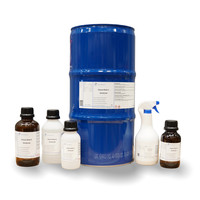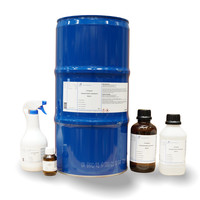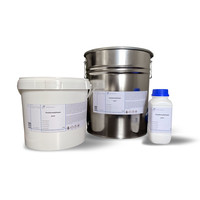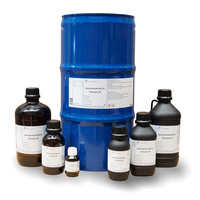You have no items in your shopping cart
Formaldehyde 37%
- Buy 2 and save 5%
- Buy 6 and save 10%
What is Formaldehyde?
Formaldehyde or formalin (systematic name methanal) is an organic chemical compound with the empirical formula CH2O and the simplest representative of the group of aldehydes. Under standard conditions, formaldehyde is a gas with a pungent odor.
With an annual production of about 21 million tons (as of 2019, based on 100% formaldehyde), formaldehyde is one of the most widely produced organic chemicals. The technical production of formaldehyde takes place catalytically by oxidation or dehydrogenation of methanol, for example in the silver catalyst process or in the Formox process. In the chemical industry, it is mainly used as a starting material in the production of phenolic and urea resins. Another polymer is paraformaldehyde, which is used in cell biology, among other things. It is a powerful antiseptic and disinfectant available as a 40 percent solution of the aldehyde in water and used as a fungicide and preservative.
In nature, formaldehyde occurs as an oxidation product of terpenes and as a metabolic product of bacteria, which aerobically convert substrates containing a carbon atom such as methanol, methane or methylamine into carbon dioxide. Formaldehyde is part of human metabolism. It is classified as a carcinogen.
What is formaldehyde used for?
Formaldehyde is one of the most important organic raw materials in the chemical industry and is used as a raw material for many other chemical compounds. By far the largest market is urea-formaldehyde resins, phenoplasts, polyoxymethylenes and a number of other chemical intermediates such as pentaerythritol. Formaldehyde is used, among other things, in the production of dyes, pharmaceutical products and in textile finishing. Because formaldehyde, like all aldehydes, is a strong reducing agent, it is used to kill germs. Formaldehyde is used in the laboratory for the Mannich reaction and the Blanc reaction, among other things.
-Polymer manufacturing
Formaldehyde reacts with urea to form urea-formaldehyde resins (UF resins; from urea-formaldehyde), with melamine it reacts to form melamine-formaldehyde resins (MF resins), both of which are aminoplasts. In the first step, monomethylolurea and dimethylolurea are produced
Further condensation results in chain-like polymers that can eventually be crosslinked. Urea-formaldehyde based resins are the main types of adhesive resins for the manufacture of wood based materials such as chipboard, fiberboard and hardwood plywood. The lack of water resistance of the cured resin due to the reversibility of the aminomethylene bond can be remedied by adding substances such as melamine.
By far the largest application area for formaldehyde is the production of urea-formaldehyde resins, which are used as binders for non-structural wood-based materials such as chipboard and medium density fibreboard (MDF).
Melamine-formaldehyde resins are used as impregnating resins when there are higher requirements for moisture resistance, for example for the application of decorative paper on laminate floors. In the form of clear coats, MF resins are used in the automotive industry.
N-methylol compounds made from formaldehyde and urea, such as methylolurea, which form aminoplasts in the fiber through further condensation, are used as textile auxiliaries in cellulosic fibers such as cotton fiber or viscose fiber. These serve to improve the creasing and shrinkage behavior and thus increase the dimensional stability of textiles. The polycondensation of the N-methylol compounds usually takes place in an acid medium at an elevated temperature. Formaldehyde is produced to some extent during condensation. The amount of stored aminoplasts is about 8% based on the weight of the textile. From a health point of view, textile finishing should ensure a small amount of free and releasable formaldehyde. Textiles that come into contact with the skin during normal use and that contain more than 0.15 percent free formaldehyde must be labeled accordingly.
- Phenoplasts
Phenol-formaldehyde resins (PF) or phenoplasts are synthetic polymers made by the condensation reaction of phenol or substituted phenol with formaldehyde. Novolaks or resoles are formed depending on whether the condensation is acidic or basic. Novolaks are low molecular weight polymers produced by the acid-catalyzed condensation of formaldehyde with a mixture of cresols. Novolaks are used as photoresist materials in microelectronics.
Resoles are products of the base-catalyzed phenol-formaldehyde condensation. They are made with an excess of formaldehyde to phenol. The reactive species are phenates, which are formed by deprotonation of phenol. As thermosets, the hydroxymethylphenols formed a cross-link when heated to about 120 °C, forming methylene and methyl ether bridges with the removal of water. A high degree of cross-linking across the Resitol and Resit levels gives the Resoles hardness, thermal stability and chemical resistance.
Phenol-formaldehyde resins are added to hexamethylenetetramine as a curing component. It is produced industrially by reacting six equivalents of formaldehyde with four equivalents of ammonia.
Cation exchangers are created by the co-condensation of phenol, phenol sulfonic acid and formaldehyde. These network polymers have both tightly bound anionic sulfate groups and free moving cations.
-Polyoxymethylene
Polyoxymethylene is a thermoplastic used in precision parts requiring low friction and high dimensional stability. Polyoxymethylene is characterized by high strength, hardness and rigidity. Due to its high crystallinity, it is uncoloured, opaque white. The automotive and electronics industries use injection molded POM for engineering components such as gears, ball bearings and fasteners.
-Pentaerythritol manufacturing
Pentaerythritol is produced via a base-catalyzed polyaddition reaction between acetaldehyde and three equivalents of formaldehyde. The intermediate reacts in a crossed Cannizzaro reaction with a fourth equivalent of formaldehyde to form pentaerythritol.
Synthesis of pentaerythritol
It is mainly used to make polyfunctional compounds and can be found in plastics, paints, cosmetics and many other applications. It is also used to manufacture explosives such as nitropenta and pentaerythritol trinitrate.
-Methylene diphenyl isocyanate
The first step in the production of methylene diphenyl isocyanates (MDI) is the reaction of aniline and formaldehyde with hydrochloric acid as a catalyst.
-Diaminodiphenylmethane
A mixture of diamine precursors and the corresponding polyamines is produced. The global production of methylene diphenyl isocyanates in 2018 was about 9.8 million tons, requiring about 1.2 million tons of formaldehyde. The manufacture of methylene diphenyl isocyanates is a fast growing market for formaldehyde. The main applications are polyurethane foams, paints, adhesives, elastomers and sealants, which are used in construction, household appliances, footwear and other consumer goods, as well as in the automotive industry.
-1,4-butanediol
The industrial synthesis of 1,4-butanediol takes place via the reaction of acetylene with two equivalents of formaldehyde.
Reaction of acetylene with formaldehyde to give 2-butyne-1,4-diol in the presence of a bismuth/copper acetylide catalyst
The 2-butyne-1,4-diol formed in the first step gives 1,4-butanediol by hydrogenation.
Hydrogenation of 2-butyne-1,4-diol to 1,4-butanediol in the presence of a Raney nickel catalyst
1,4-Butanediol is used as a solvent and in the manufacture of plastics, elastic fibers and polyurethanes. At a higher temperature in the presence of phosphoric acid, it cyclizes with elimination of water to tetrahydrofuran, an important secondary product.
-Formaldehyde releasers
Formaldehyde is usually used in cosmetic products in the form of a formaldehyde releaser. These are condensation products of formaldehyde such as diazolidinyl urea, which release it slowly in cosmetic products as a biocide for preservation. EU Regulation 2019/831 amending the Cosmetics Regulation stipulates that formaldehyde is removed from the list of permitted substances and included in the list of substances prohibited in cosmetic products.
Annex V of the EU Cosmetics Regulation regulates the use of formaldehyde in cosmetic products in the European Union. It is approved as an active ingredient in nail hardeners up to a concentration of 5% and as a preservative in oral care products up to 0.1% and generally in cosmetics up to 0.2%. If a concentration of free formaldehyde of 0.05% is exceeded in the cosmetic product, this must be indicated in the form of the statement "Contains formaldehyde".
-In vaccines
Formaldehyde is used in vaccine production to inactivate vaccine viruses (e.g., poliovirus) or bacterial toxins (e.g., diphtheria toxin, tetanus toxin, or pertussis toxin). After purification, the finished vaccine preparation may contain a maximum of 200 mg (human vaccines) or 500 mg (animal vaccines) of formaldehyde per litre. In human vaccines, this corresponds to a maximum concentration of max. 0.2 mg/ml or 0.02%. Typically, 1–200 µg is injected per vaccine. The amount of a single vaccination in humans is about at least 600 times less than the amount that can cause toxicity in animal studies. Since the amount of formaldehyde is often below the permitted maximum anyway and a concentration of 1% is usually used for a patch test for formaldehyde for allergy testing, the amount of formaldehyde in a vaccine cannot cause skin reactions - even if it is applied directly into or on the skin to be applied. There is about 10 times more formaldehyde circulating in the blood than is contained in a vaccine. The amount of formaldehyde in the muscle is so small that the physiological formaldehyde content of the muscle is even diluted by vaccination. So there is no risk of formaldehyde poisoning after vaccination.
-Preservation of anatomical and biological specimens
4 to 8 percent formaldehyde solution is used as a common fixative in histotechnology. Formaldehyde is an additive fixative for cross-linking proteins, stopping the autolysis and putrefaction of tissue samples and making them permanently durable. The rule of thumb is a penetration speed of 1mm/h. The cross-linking rate is significantly slower than the primary accumulation of formaldehyde; a minimum of 2-3 days are required for adequate fixation. Methylene bridges and bridges across Schiff's bases are formed. The compound can be reversed by rinsing in water or by the action of hot buffer solutions with different pH values (antigen retrieval). Methylene bridges must be stable. The cross-linking and modification of biomolecules with formaldehyde can be reversed by heating and/or adding bases.
Such formaldehyde solution is also used for preserving corpses and for preserving anatomical and biological specimens such as insects, first proposed in 1893 by Isaak Blum. Because material introduced in this way lasts for years, it can easily be used as illustrative or comparative material in medicine and biology for research and teaching purposes. British artist Damien Hirst preserved a shark as a work of art in formaldehyde for artistic purposes.
Despite formaldehyde's health risks, its general antiseptic properties still make it largely indispensable in tissue preservation. However, the technical conversion of work areas to comply with the occupational exposure limit, for example through direct extraction to the work area and the reduction of the concentration of formaldehyde in preservative solutions, is a central theme in modern anatomy and pathology.
-Disinfection and sterilization
Formaldehyde is used in various ways for disinfection and sterilization. To disinfect rooms, formaldehyde in gaseous form or in an aqueous solution is applied to all surfaces in a room. In addition to evaporation, formaldehyde can be atomized or substances that release formaldehyde can be used. In addition, disinfection can be carried out by wiping with agents containing formaldehyde. In addition, formaldehyde is adsorbed by surfaces and must be thoroughly removed by rinsing after treatment. For small medical parts, decontamination with formaldehyde can take place in formaldehyde sterilizers.
In intensive livestock farming, formaldehyde is used as a disinfectant to prevent infectious diseases caused by viruses or bacteria. For example, when rearing and fattening chickens, fumigation is usually carried out before refilling the houses.
Buy formaldehyde?
Do you need formaldehyde and don't want to pay too much? Then you have come to the right place at Laboratorydiscounter! Delivered quickly and of high quality! So order your formaldehyde at Laboratoriumdiscounter, always with volume discount!
Stabilised with methanol.
Formol, Formalin
Empirical formula CH2O
Molar mass (M) 30,03 g/mol
Dichtheid 1,09
Boiling point (bp) 99 °C
Flash point (flp)62 °C
Storage temp.: >+15 °C
ADR 8 III • WGK 3
CAS No.[50-00-0]
EG-Nr. 200-001-8 • UN-Nr. 2209
$$$$$
Hazard statements
H301 + H311 + H331 Toxic if swallowed, in contact with skin or if inhaled
H314 Causes severe burns and eye damage
H317 May cause an allergic skin reaction
H335 May cause respiratory irritation
H341 Suspected of causing genetic defects
H350 May cause cancer
H370 Causes damage to organs (eye)
Safety recommendations
Precautions - prevention
P260 Do not breathe mist / vapor.
P280 Wear protective gloves / protective clothing / eye protection / face protection.
Precautionary measures -
reaction
P303 + P361 + P353 IF ON SKIN (or hair): Immediately contaminate clothing
pull out. Rinse skin with water [or shower].
P304 + P340 IF INHALED: Remove person to fresh air and keep comfortable for breathing.
P305 + P351 + P338 IF IN EYES: Rinse cautiously with water for a long period of time
amount of minutes; remove contact lenses, if possible; keep rinsing.
P308 + P311 IF exposure or potential exposure: Call a POISON CENTER / doctor.



%%%%%
| MSDS Formaldehyde (NL) |
| MSDS Formaldehyd (DE) |
| MSDS Formaldehyde (EN) |
| MSDS Formaldéhyde (FR) |
| MSDS Formaldehído (ES) |






